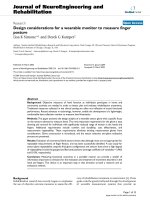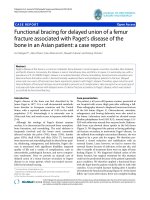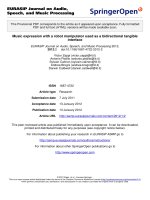Báo cáo toán học: " Lyapunov-type inequalities for a class of even-order differential equations" doc
Bạn đang xem bản rút gọn của tài liệu. Xem và tải ngay bản đầy đủ của tài liệu tại đây (199 KB, 12 trang )
This Provisional PDF corresponds to the article as it appeared upon acceptance. Fully formatted
PDF and full text (HTML) versions will be made available soon.
Lyapunov-type inequalities for a class of even-order differential equations
Journal of Inequalities and Applications 2012, 2012:5 doi:10.1186/1029-242X-2012-5
Qi-Ming Zhang ()
Xiaofei He ()
ISSN 1029-242X
Article type Research
Submission date 19 October 2011
Acceptance date 12 January 2012
Publication date 12 January 2012
Article URL />This peer-reviewed article was published immediately upon acceptance. It can be downloaded,
printed and distributed freely for any purposes (see copyright notice below).
For information about publishing your research in Journal of Inequalities and Applications go to
/>For information about other SpringerOpen publications go to
Journal of Inequalities and
Applications
© 2012 Zhang and He ; licensee Springer.
This is an open access article distributed under the terms of the Creative Commons Attribution License ( />which permits unrestricted use, distribution, and reproduction in any medium, provided the original work is properly cited.
Lyapunov-type inequalities for a class of
even-order differential equations
Qi-Ming Zhang
∗1
and Xiaofei He
2
1
College of Science, Hunan University of Technology, Zhuzhou,
Hunan 412000, P.R. China
2
College of Mathematics and Computer Science, Jishou University,
Jishou 416000, Hunan, P.R. China
∗
Corresponding author:
Email address:
XH:
Abstract
We establish several sharper Lyapunov-type inequalities for the following even-order
differential equation
x
(2n)
(t) + (−1)
n−1
q(t)x(t) = 0.
These results improve some existing ones.
Keywords: even-order; differential equation; Lyapunov-type inequality.
2000 Mathematics Subject Classification: 34B15.
1
1. Introduction
In 1907, Lyapunov [1] first established the Lyapunov inequality for the Hill’s equation
x
(t) + q(t)x(t) = 0, (1.1)
which was improved to the following classical form
(b − a)
b
a
q
+
(t)dt > 4 (1.2)
by Wintner [2] in 1951, if (1.1) has a real solution x(t) such that
x(a) = x(b) = 0, x(t) ≡ 0, t ∈ [a, b], (1.3)
where a, b ∈ R with a < b, and the constant 4 cannot be replaced by a larger number,
where and in the sequel q
+
(t) = max{q(t), 0}. Since then, there are many improvements
and generalizations of (1.2) in some literatures. Especially, Lyapunov inequality has been
generalized extensively to the higher-order linear equations and the linear Hamiltonian sys-
tems. A thorough literature review of continuous and discrete Lyapunov-type inequalities
and their applications can be found in the survey article by Cheng [3]. Some other recent
related results can be found in the articles [4–14].
We consider the even-order equation
x
(2n)
(t) + (−1)
n−1
q(t)x(t) = 0, (1.4)
where n ∈ N, q(t) is a locally Lebesgue integrable real-valued function defined on R. While
n = 1, the equation (1.4) reduces to the equation (1.2).
For (1.4), there are several literatures having established some Lyapunov-type inequal-
ities. For example, Yang [15,16] and Cakmak [17] have contributed to these interesting
2
results. In the recent article [18], He and Tang improved and generalized the above results
and obtained the following Lyapunov-type inequality.
Theorem 1.1. [18] Let n ∈ N and n ≥ 2, q ∈ L
1
([a, b], R). If (1.4) has a solution x(t)
satisfying the boundary value conditions
x
(2i)
(a) = x
(2i)
(b) = 0, i = 0, 1, . . . , n − 1, x(t) ≡ 0, t ∈ (a, b), (1.5)
then
b
a
q
+
(t)[(t − a)(b − t )]
2
dt >
32
45
(1−cosnπ)/4
2
(n−2)/2
3
n−1
5
(n−2)/2
(b − a)
2n−5
. (1.6)
In this article, motivated by the references [15–18], we attempt to establish some sharper
Lyapunov-type inequalities for (1.4) under the same boundary value conditions of Theorem
1.1.
2. Main results
In the proof of our results, the following lemma is very important.
Lemma 2.1.[18] Assume that x(t) is a continuous real-valued function on [a, b], x(a) =
x(b) = 0, x(t) ≡ 0 for t ∈ [a, b], and x
∈ L
2
([a, b], R). Then
|x(t)| ≤
(t − a)(b − t )
3(b − a)
b
a
|x
(s)|
2
ds
1/2
, ∀ t ∈ [a, b]. (2.1)
In the meantime, in order to obtain Lemma 2.3 which also plays an important role in
this article, we will apply the following inequality. See Lemma 2.2.
Lemma 2.2.[19] Assume that f (t) and f
(t) are continuous on [α, β], f(α) = f(β) and
3
β
α
f(t)dt = 0. Then
β
α
|f(t)|
2
dt ≤
β − α
2π
2
β
α
|f
(t)|
2
dt. (2.2)
Lemma 2.3. Assume that x(t) is a continuous real-valued function on [a, b], x(a) =
x(b) = 0, x(t) ≡ 0 for t ∈ [a, b], and x
, x
∈ L
2
([a, b], R). Then
b
a
|x(t)|
2
dt ≤
(b − a)
2
π
2
b
a
|x
(t)|
2
dt, (2.3)
b
a
|x(t)|
2
dt ≤
(b − a)
4
π
4
b
a
|x
(t)|
2
dt. (2.4)
Proof. At first, we construct a function f(t) as follows
f(t) =
x(t), t ∈ [a, b];
−x(2a − t), t ∈ [2a − b, a].
Let α = 2a − b, β = b. Since x(a) = x(b) = 0, x(t) ≡ 0 for t ∈ [a, b ], and taking into
account of the definition of f (t), we can easily obtain that
b
a
f(t)dt = 0 and f(α) = f(β).
Moreover, it is obvious that f(t) and f
(t) are continuous on [α, β], since x(t) is a continuous
real-valued function on [ a, b]. Hence, it follows from Lemma 2.2 that
β
α
|f(t)|
2
dt ≤
2(b − a)
2π
2
β
α
|f
(t)|
2
dt. (2.5)
Since
β
α
|f(t)|
2
dt =
a
2a−b
| − x(2a − t )|
2
dt +
b
a
|x(t)|
2
dt = 2
b
a
|x(t)|
2
dt, (2.6)
and
β
α
|f
(t)|
2
dt =
a
2a−b
| − x
(2a − t)|
2
dt +
b
a
|x
(t)|
2
dt = 2
b
a
|x
(t)|
2
dt, (2.7)
it follows from (2.5), (2.6), and (2.7) that
2
b
a
|x(t)|
2
dt ≤ 2
2(b − a)
2π
2
b
a
|x
(t)|
2
dt, (2.8)
4
which implies that the inequality (2.3) holds.
Next, we’ll prove that the inequality (2.4) holds.
For convenience, we only consider the special case a = 0. At this moment, the interval
[α, β] reduces to [−b, b]. It follows from the construction of f(t), that f (t) is an odd function
on [−b, b], so we have f(−t) = −f (t). Then, according to the definition of derivation, we
have
f
+
(−b) = lim
t→0
+
f(t − b) − f(−b)
t
= lim
t→0
+
−f(b − t) + f(b)
t
= lim
t→0
+
f(b − t) − f(b)
−t
= lim
s→0
−
f(b + s) − f(b)
s
= f
−
(b). (2.9)
It follows from (2.9) that f
(α) = f
(β). Furthermore, we can easily obtain
β
α
f
(t)dt = 0
for the property that f(t) is an odd function on [α, β]. And the condition that f
(t) is
continuous on [α, β] implies that f
(t) is continuous on [α, β], too. Then, by a similar
method to the proof of (2.3) together with Lemma 2.2, we can obtain (2.4) immediately.
For the other ordinary cases, i.e., a = 0, we only need to move the interval [α, β] evenly
such that this interval symmetrizes about the origin. Then, similar to the proof of (2.9), we
can verify the condition f
(α) = f
(β), and the other conditions in Lemma 2.2 are satisfied
all the way. Hence, it also follows from Lemma 2.2 that (2.4) holds.
Theorem 2.4. Let n ∈ N, q ∈ L
1
([a, b], R). If (1.4) has a solution x(t) satisfying the
boundary value conditions (1.5), then
b
a
|q(t)|
2
dt ≥
48π
4(n−1)
(b − a)
4n−1
. (2.10)
5
Proof. Choose c ∈ (a, b) such that |x(c)| = max
t∈[a,b]
|x(t)|. It follows from (1.5) that
x(a) = x(b) = 0, x(t) ≡ 0 for t ∈ [a, b], which implies that |x(c)| > 0. Since (1.5), together
with (1.4), Lemmas 2.1 and 2.3, we have
|x(c)|
2
≤
(b − a)
3
48
b
a
|x
(t)|
2
dt
≤
(b − a)
3
48
(b − a)
4
π
4
n−1
b
a
|x
(2n)
(t)|
2
dt
=
(b − a)
3
48
(b − a)
4
π
4
n−1
b
a
|q(t)|
2
|x(t)|
2
dt. (2.11)
Since |x(c)| > 0, divided the last inequality of (2.11) by |x(c)|, we can obtain (2.10).
By a similar method in the proof of Theorem 1.1, applying Lemmas 2.1 and 2.3, we can
obtain the following result:
Theorem 2.5. Let n ∈ N and n ≥ 2, q ∈ L
1
([a, b], R). If (1.4) has a solution x(t)
satisfying the boundary value conditions (1.5), then
b
a
q
+
(t)[(t − a)(b − t)]
2
dt ≥
3π
2n−4
(b − a)
2n−5
. (2.12)
Proof. From (1.5), multiplying (1.4) by x(t) and integrating by parts over [a, b], we have
b
a
x
(2n)
(t)x(t)dt = (−1)
n
b
a
|x
(n)
(t)|
2
dt. (2.13)
Combining (1.4) and (2.13), we have
b
a
q(t)|x(t)|
2
dt =
b
a
|x
(n)
(t)|
2
dt. (2.14)
Case 1. If n = 2m is an even number, then
b
a
q(t)|x(t)|
2
dt =
b
a
x
(2m)
(t)
2
dt. (2.15)
6
It follows from (1.5), (2.1), and (2.4) that
|x(t)|
2
≤
[(t − a)(b − t)]
2
3(b − a)
b
a
|x
(s)|
2
ds, ∀ t ∈ [a, b], (2.16)
and
b
a
x
(2i)
(t)
2
dt ≤
(b − a)
4
π
4
b
a
x
(2i+2)
(t)
2
dt, i = 1, 2, . . . , m − 1. (2.17)
From (2.15), (2.16), and (2.17), we have
b
a
q
+
(t)|x(t)|
2
dt ≤
b
a
[(t − a)(b − t)]
2
3(b − a)
q
+
(t)dt
b
a
|x
(t)|
2
dt
≤
1
3(b − a)
(b − a)
4
π
4
m−1
b
a
q
+
(t)[(t − a)(b − t)]
2
dt
b
a
x
(2m)
(t)
2
dt
=
(b − a)
4m−5
3π
4(m−1)
b
a
q
+
(t)[(t − a)(b − t )]
2
dt
b
a
q(t)|x(t)|
2
dt
≤
(b − a)
4m−5
3π
4(m−1)
b
a
q
+
(t)[(t − a)(b − t )]
2
dt
b
a
q
+
(t)|x(t)|
2
dt. (2.18)
Now, we claim that
b
a
q
+
(t)|x(t)|
2
dt > 0. (2.19)
If (2.19) is not true, we have
b
a
q
+
(t)|x(t)|
2
dt = 0. (2.20)
From (2.15) and (2.20), we have
0 ≤
b
a
x
(2m)
(t)
2
dt =
b
a
q(t)|x(t)|
2
dt ≤
b
a
q
+
(t)|x(t)|
2
dt = 0, (2.21)
which implies that
b
a
x
(2m)
(t)
2
dt ≡ 0. (2.22)
7
Then, from (2.22), we can obtain x
(2m)
(t) = 0, for t ∈ [a, b], which contradicts (1.5). So,
(2.19) holds, and divided the last inequality of (2.18) by
b
a
q
+
(t)|x(t)|
2
dt, we can obtain
b
a
q
+
(t)[(t − a)(b − t )]
2
dt ≥
3π
4(m−1)
(b − a)
4m−5
. (2.23)
That is
b
a
q
+
(t)[(t − a)(b − t)]
2
dt ≥
3π
2n−4
(b − a)
2n−5
. (2.24)
Case 2. If n = 2m + 1 is an odd number, then
b
a
q(t)|x(t)|
2
dt =
b
a
x
(2m+1)
(t)
2
dt. (2.25)
In one hand, it follows from (1.5), (2.1), and (2.4) that (2.16) and (2.17) hold. In the other
hand, since x
(2m)
(a) = x
(2m)
(b) = 0, it follows from (2.3) that
b
a
x
(2m)
(t)
2
dt ≤
(b − a)
2
π
2
b
a
x
(2m+1)
(t)
2
dt. (2.26)
Hence, combining (2.16), (2.17), (2.25) with (2.26), we have
b
a
q
+
(t)|x(t)|
2
dt ≤
b
a
[(t − a)(b − t)]
2
3(b − a)
q
+
(t)dt
b
a
|x
(t)|
2
dt
≤
1
3(b − a)
(b − a)
4
π
4
m−1
b
a
q
+
(t)[(t − a)(b − t)]
2
dt
b
a
x
(2m)
(t)
2
dt
≤
b − a
3π
2
(b − a)
4
π
4
m−1
b
a
q
+
(t)[(t − a)(b − t )]
2
dt
b
a
x
(2m+1)
(t)
2
dt
=
(b − a)
4m−3
3π
4m−2
b
a
q
+
(t)[(t − a)(b − t )]
2
dt
b
a
q(t)|x(t)|
2
dt
≤
(b − a)
4m−3
3π
4m−2
b
a
q
+
(t)[(t − a)(b − t )]
2
dt
b
a
q
+
(t)|x(t)|
2
dt, (2.27)
Since (2.19), divided the last inequality of (2.27) by
b
a
q
+
(t)|x(t)|
2
dt, we can obtain
b
a
q
+
(t)[(t − a)(b − t )]
2
dt ≥
3π
4m−2
(b − a)
4m−3
. (2.28)
8
That is
b
a
q
+
(t)[(t − a)(b − t)]
2
dt ≥
3π
2n−4
(b − a)
2n−5
. (2.29)
It follows from (2.24) and (2.29) that (2.12) holds.
Remark 2.6. In view of the forms of the two inequalities (1.6) and (2.12), we can easily
find that inequality (2.12) is simpler than (1.6). Moreover, by using the method of induction,
we can verify that inequality (2.12) is sharper than inequality (1.6).
Corollary 2.7. Let n ∈ N and n ≥ 2, q ∈ L
1
([a, b], R). If (1.4) has a solution x(t)
satisfying the boundary value conditions (1.5), then
b
a
q
+
(t)dt ≥
48π
2n−4
(b − a)
2n−1
. (2.30)
Competing interests
The authors declare that they have no competing interests.
Authors’ contributions
QZ carried out the theoretical proof and drafted the manuscript. XH participated in the
design and coordination. Both of the two authors read and approved the final manuscript.
References
[1] Liapunov, AM: Probl`eme g´en´eral de la stabilit´e du mouvement (Russian). Ann. Fac.
Sci. Univ. Toulouse 2, 203–407 (1907)
9
[2] Hartman, P, Wintner, A: On an oscillation criterion of Lyapunov. Am. J. Math. 73,
885–890 (1951)
[3] Cheng, SS: Lyapunov inequalities for differential and difference equations. Fasc. Math.
23, 25–41 (1991)
[4] He, Z: Existence of two solutions of m-point boundary value problem for second dy-
namic equations on time scales. J. Math. Anal. Appl. 296, 97–109 (2004)
[5] Jiang, LQ, Zhou, Z: Lyapunov inequality for linear Hamiltonian systems. J. Math.
Anal. Appl. 310, 579–593 (2005)
[6] Kwong, MK: On Lyapunov’s inequality for disfocality. J. Math. Anal. Appl. 83, 486–
494 (1981)
[7] Lee, C, Yeh, C, Hong, C, Agarwal, RP: Lyapunov and Wirtinger inequalities. Appl.
Math. Lett. 17, 847–853 (2004)
[8] Pachpatte, BG: On Lyapunov-typ e inequalities for certain higher order differential
equations. J. Math. Anal. Appl. 195 , 527–536 (1995)
[9] Tang, XH, Zhang, M: Lyapunov inequalities and stability for linear Hamiltonian sys-
tems. J. Diff. Eqs. 252, 358–381 (2012)
[10] Wang, X: Stability criteria for linear periodic Hamiltonian systems. J. Math. Anal.
Appl. 367, 329–336 (2010)
[11] Wang, X: Lyapunov type inequalities for second-order half-linear differential equations.
J. Math. Anal. Appl. 382, 792–801 (2011)
10
[12] Yang, X, Kim, Y, Lo, K: Lyapunov-type inequalities for a class of quasilinear systems.
Math. Comput. Model. 53, 1162–1166 (2011)
[13] Zhang, Q, Tang, XH: Lyapunov inequalities and stability for discrete linear Hamiltonian
system. Appl. Math. Comput. 2, 574–582 (2011)
[14] Zhang, Q, Tang, XH: Lyapunov inequalities and stability for discrete linear Hamiltonian
systems. J. Diff. Equ. Appl. (in press). doi:10.1080/10236198.2011.572071
[15] Yang, X: On inequalities of Lyapunov type. Appl. Math. Comput. 134, 293–300 (2003)
[16] Yang, X: On Liapunov-type inequality for certain higher-order differential equations.
Appl. Math. Comput. 134(2–3), 307–317 (2003)
[17] Cakmak, D: Lyapunov-type integral inequalities for certain higher order differential
equations. Appl. Math. Comput. 216, 368–373 (2010)
[18] He, X, Tang, XH: Lyapunov-type inequalities for even order differential equations.
Commun. Pure Appl. Anal. 11(2), 465–473 (2012)
[19] Almansi, E: Sopra una delle esperienze di Plateau (Russian). Ann. Mat. Pura. Appl.
12, 1–17 (1905)
11









